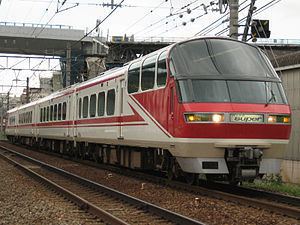Type Commuter rail Stations 60 Owner Meitetsu | Native name 名鉄名古屋本線 Locale AichiGifu Daily ridership 221,098 (2008) | |
 | ||
1200 meitetsu nagoya main line 1200 series emu
The Meitetsu Nagoya Main Line (名鉄名古屋本線, Meitetsu Nagoya Honsen) or Nagoya Line is a railway line operated by the private railway operator Nagoya Railroad (Meitetsu), connecting Toyohashi Station in Toyohashi with Meitetsu Gifu in Gifu.
Contents
- 1200 meitetsu nagoya main line 1200 series emu
- 3300 meitetsu nagoya main line 3300 series emu
- Basic data
- Service patterns
- Stations
- History
- Former connecting lines
- References
Since its amalgamation in 1944 (see History section) this has been the Meitetsu main line. Many branch lines of Meitetsu have through services to/from the Nagoya Line. Toyokawa, Nishio, Tokoname (which has its through services with Airport, Kōwa, Chita), and Inuyama lines all have through services bound for Meitetsu Nagoya, making the segment around that station extremely busy. Between Biwajima Junction and Kanayama, 26 trains proceed per hour, even during off-peak periods. All the stations accept manaca, a Smart card.
The line largely parallels the Tōkaidō Main Line in the Chūkyō Metropolitan Area (Greater Nagoya). Local traffic on the Nagoya Line used to be much heavier than on the Tōkaidō Main Line, but since the privatization of the Japanese National Railways (JNR), transforming into the Central Japan Railway Company (JR Central) in this area, competition has become more significant in the Chūkyō area.
Due to historical reasons, the line shares its track between Hirai Junction and Toyohashi Station with the JR Iida Line. The agreement between two companies prohibits Meitetsu to have more than 6 trains in one direction per hour on the 3.8 km of shared tracks. Consequently, local trains are unable to reach Toyohashi, instead, terminate at Ina Station.
3300 meitetsu nagoya main line 3300 series emu
Basic data
Service patterns
Abbreviations are tentative for this article.
Lo: Local (普通, Futsū)SE: Semi Express (準急, Junkyū)Ex: Express (急行, Kyūkō)RE: Rapid Express (快速急行, Kaisoku Kyūkō)LE: Limited Express (特急, Tokkyū)RL: Rapid Limited Express (快速特急, Kaisoku Tokkyū)MU: μSKY Limited Express (ミュースカイ, Myū Sukai)Stations
For abbreviations of rapid trains, refer to the above section. For distances and connections, see the route diagram.
Some trains stop at stations indicated by lower case. At Sukaguchi, Limited Expresses only from Tsushima Line stop, shown as LE*. For distances and transfers, see the route diagram.
1: Some trains of the marked line directly go through Nagoya Line bound for Meitetsu Nagoya.2: All trains of Inuyama line directly go through Nagoya Line bound for Meitetsu Nagoya.2: Some trains of Takehana line directly go through Nagoya Line bound for Meitetsu Gifu.History
Four different companies built sections of the line, which were subsequently amalgamated and linked to create today's line.
The Marunouchi to Kōnomiya section was opened by the Nagoya Railway in 1928, the Ichinomiya to Kasamatsu section was opened by the Meigi Railway in 1935, and by 1935 the line was dual track as far as Kanō. Meanwhile, the Aichi Electric Railway opened the Jingu-mae to Arimatsu section in 1917 (Arimatsu Line), electrified at 600 V DC, and extended the line to Toyohashi in 1927 (becoming the Toyohashi Line). The Narumi to Yahagibashi section was double-tracked in 1924, and by 1935, the line was double-tracked from Horita to the Hirai Signal Box. The voltage on the line was increased to 1,500 V DC in 1925.
In 1935 the Aichi Electric Railway merged with Meigi Railway, and the company changed its name to Nagoya Railroad. The Jingū-mae to Horita section was double-tracked in 1942, and in 1944, the Nagoya to Jingū-mae section opened as dual track, linking the two sections, although through-running was not possible until the voltage on the Nagoya to Gifu section had been increased to 1,500 V DC in 1948. The line was renamed the Nagoya Main Line.
Former connecting lines
The Mino Electric Railway opened an 18 km 1,067 mm gauge line electrified at 600 V DC to Hon Ibi in 1928. The company merged with Meitetsu in 1930, the line closed in 2001. An 11 km 1,067 mm gauge branch from Kurono (5 km from Hon Ibi) was opened by the Tanigumi Railway to its namesake town in 1926, electrified at 600 V DC. The company merged with Meitetsu in 1944, and the line closed in 2001.
The Nagara Light Railway opened a 5 km 1,067 mm gauge line to Takatomi in 1915, and was acquired by the Mino Electric Railway in 1920, which electrified the line at 600 V DC, merging with Meitetsu in 1930. The line closed in 1960.
